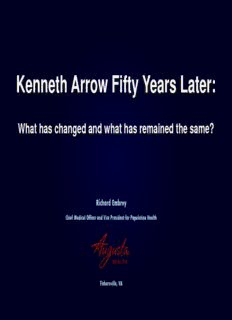
Kenneth Arrow Fifty Years Later PDF
Preview Kenneth Arrow Fifty Years Later
Kenneth Arrow Fifty Years Later: What has changed and what has remained the same? Richard Embrey Chief Medical Officer and Vice President for Population Health Fishersville, VA In Memoriam Kenneth Joseph Arrow • Born New York City • B.A., City College of New York, 1940 • Ph.D., Columbia University, 1951 • Professor of Economics, Stanford University • John Clark Bates Medal, 1957 • Nobel Memorial Prize in Economics, 1972 • Von Neumann Theory Prize, 1986 • National Medal of Science, 2004 August 23, 1921 – February 21, 2017 Professor Arrow’s most significant works were his contributions to social choice theory, welfare economics and general equilibrium analysis. Arrow also provided foundational work in many other areas of economics, including endogenous growth theory and the economics of information. “The most important paper about healthcare that no one in healthcare has actually ever read.” Putting Arrow’s “Uncertainty” paper in context • In 1963, Arrow was already well established as a leading “neo-classical” economist, having published groundbreaking work on competitive equilibrium that provided the foundation for modern economic thinking about the extent to which markets can or cannot reach welfare-maximizing equilibria. • Arrow was invited by the Ford Foundation to examine medical markets as part of a larger effort to address policy areas with substantial public-private overlap (health, education, welfare) • Arrow had to educate himself about health care and health insurance services before he could apply himself to the question. • In 1963, medicine still consisted largely of a single physician treating a single patient with relatively rudimentary remedies and medications. • At the time Arrow penned “Uncertainty and the Welfare Economics of Medical Care,” government involvement with medical care was limited; insurance covered less than half of all medical expenditures, compared with more than 85% today. SavedoffWD. Kenneth Arrow and the birth of health economics. Bull World Health Org82(2), Feb.2004. Putting Arrow’s “Uncertainty” paper in context • In the intervening half century, medicine has been revolutionized by technological advances in the understanding and treatment of illnesses, and has been transformed by Medicare and Medicaid, malpractice, and managed care. • Stimulated in part by rising incomes, spending on health services has increased dramatically in all of the world's high- and middle-income countries, leading to increased concerns about cost-containment, quality and responsiveness. Many of these countries, even if they have predominantly public systems, have introduced more market elements to relieve pressure on public services or to encourage greater productivity and allocative efficiency. • Many of the non-market institutions that Arrow described, such as trust that physicians would not be motivated by profit and beliefs that the medical profession could regulate itself, have eroded. SavedoffWD. Kenneth Arrow and the birth of health economics. Bull World Health Org82(2), Feb.2004. Despite changes in health care, the relevance of “Uncertainty” has increased rather than decreased Period of Publication First Ten Years Most Recent Ten Ratio – Last (1963-1972) Years (1991-2000) Ten years to First Ten Number % Number % Years Economics 26 51% 95 34% 3.65 Non-economics 25 49% 187 66% 7.48 Total 51 100% 282 100% 5.53 Breakdown of Non-economics Journals Insurance 3 6% 11 4% 3.67 Human resources/industrial relations 3 6% 3 1% 1.00 Law 6 12% 26 9% 4.33 Medicine 3 6% 48 17% 16.00 Health Policy 2 4% 52 18% 26.00 Political Science 1 2% 0 0% - Sociology 0 0% 6 2% All Other 7 14% 41 14% 5.85 Hammer PJ, Haas-Wilson D, Sage W: Kenneth Arrow and the Changing Economics of Health Care. Duke University Press, 2003. “Uncertainty” remains the 2nd most cited paper in health economics fifty years after it’s publication What questions was Arrow trying to answer? • Is the market for medical care competitive? • If not, why not? • Why should we care? “The focus of discussion will be on the way the operation of the medical-care industry and the efficacy with which it satisfies the needs of society differ from a norm, if at all. The ‘norm’ that the economist usually uses for the purposes of such comparisons is the operation of a competitive model” (p. 941) Requirements for a competitive market • All of the quality dimensions of the good or service are accurately understood by both buyer and seller • Potential buyers have full transparency on the price of the good or service • It is easy for potential sellers to enter and exit the market • There are so many buyers and sellers that none individually can affect the market price Adapted from Reinhardt, 2010. “Uncertainty” is divided into four main sections: Section I: Scope and Method Section II: A Survey of the Special Characteristics of the Medical Care Market Section III: Comparisons with the Competitive Model under Certainty Section IV: Comparison with the Ideal Competitive Model under Uncertainty
Description: